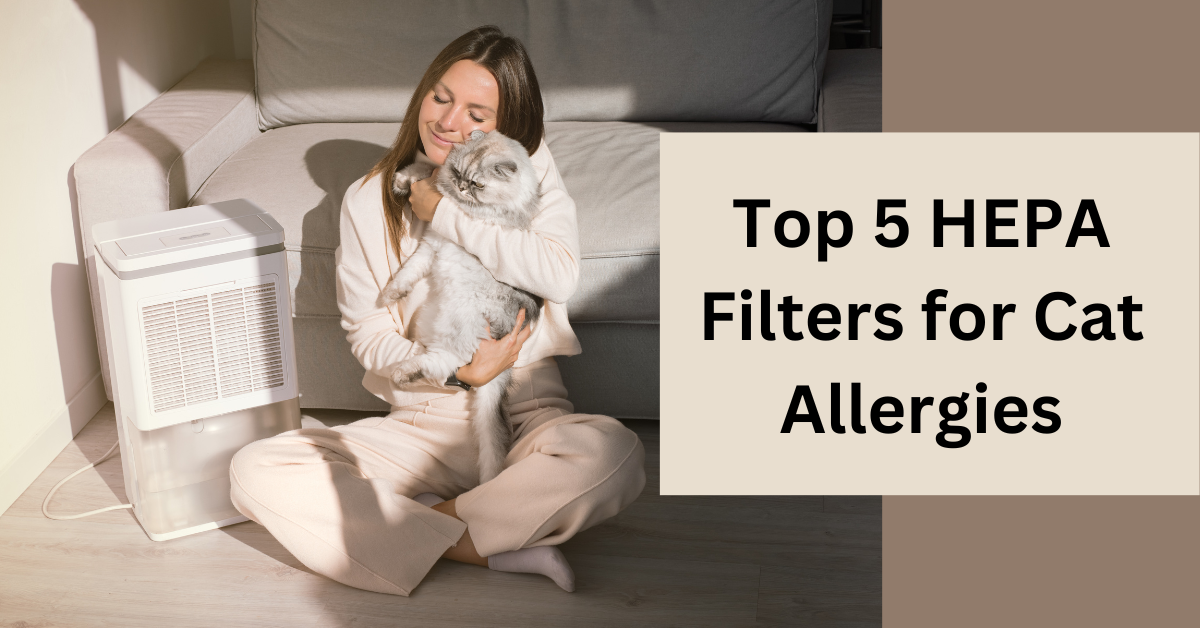HEPA Filters for Cat Allergies: Cat allergies can be a real struggle for feline lovers. The constant battle against dander and allergens can take a toll on anyone’s health. Fortunately, HEPA (High-Efficiency Particulate Air) filters come to the rescue, providing a reliable way to tackle these allergens. In this comprehensive review, we’ll explore the top 5 HEPA filters designed explicitly for combating cat allergies. Additionally, we’ll delve into the testing methods, parameters, metrics, advantages, and disadvantages associated with each filter, offering you a clear insight into their effectiveness to provide a valuable guide for your buying journey to the best air purifier to avoid cat allergies in your family.
Table of Contents
Testing Methods and Parameters
When assessing HEPA filters for their efficacy against cat allergens, several key testing methods and parameters come into play. These include:
- CADR (Clean Air Delivery Rate): Measures the volume of clean air produced by the filter, specifically in terms of pollen, dust, and smoke particles.
- HEPA Filtration Efficiency: Indicates the percentage of particles the filter can capture, especially those as small as 0.3 microns.
- Allergen Reduction: Focuses on the filter’s ability to reduce pet dander, fur, and other allergens associated with cats.
- Noise Levels: Evaluates the noise generated by the filter during operation, crucial for peaceful living environments.

Top 5 HEPA Filters for Cat Allergies
1. Honeywell HPA300 True HEPA Air Purifier
Testing Method: Evaluated through CADR (Clean Air Delivery Rate) testing, measuring its efficiency in eliminating allergens in specific room sizes.
Parameters: Filters 99.97% of airborne particles as small as 0.3 microns.
Metrics: CADR of 300+ for pollen, dust, and smoke.
Advantages: High CADR rating, suitable for large rooms, and includes an activated carbon pre-filter for odor reduction.
Disadvantages: May produce a slight noise at higher settings.
2. Winix 5500-2 Air Purifier
Testing Method: Tested against AHAM (Association of Home Appliance Manufacturers) standards for CADR.
Parameters: True HEPA filter captures 99.97% of particles down to 0.3 microns.
Metrics: CADR of 360 for dust, pollen, and smoke.
Advantages: Washable AOC carbon filter, smart sensor gauges air quality, and includes a sleep mode for silent operation.
Disadvantages: Replacement filters can be pricey.
3. Levoit Core 300 True HEPA Air Purifier
Testing Method: Evaluated through rigorous third-party testing labs.
Parameters: Filters particles as small as 0.3 microns, effectively capturing pet dander.
Metrics: CADR of 135+ for dust, pollen, and pet dander.
Advantages: Ultra-quiet operation, compact design suitable for smaller rooms, and an affordable price point.
Disadvantages: May require more frequent filter replacements.
4. Coway AP-1512HH Mighty Air Purifier
Testing Method: Certified by AHAM and Energy Star for performance and energy efficiency.
Parameters: True HEPA filter captures 99.97% of particles as small as 0.3 microns.
Metrics: CADR of 246 for dust, 240 for pollen, and 233 for smoke.
Advantages: Eco mode for energy savings, filter replacement indicator, and a sleek design.
Disadvantages: Filters may need frequent replacement in high allergen environments.
5. GermGuardian AC4825E True HEPA Filter
Testing Method: Tested against AHAM and CARB (California Air Resources Board) standards.
Parameters: True HEPA filter eliminates 99.97% of particles down to 0.3 microns.
Metrics: CADR of 118 for dust, 125 for pollen, and 108 for smoke.
Advantages: UV-C light technology to kill airborne bacteria, compact size, and a budget-friendly option.
Disadvantages: UV-C bulb replacement costs may add to long-term expenses.
FAQs on HEPA filters for cat allergies:
1. How do HEPA filters help with cat allergies?
HEPA filters are designed to capture and trap tiny particles, including pet dander, fur, and other allergens associated with cats. By effectively filtering these allergens from the air, HEPA filters can significantly reduce allergic reactions.
2. What makes HEPA filters effective against cat allergens?
HEPA filters have a high-efficiency rating, capable of capturing particles as small as 0.3 microns. This includes the majority of allergens related to cats, such as dander and fur, making them an effective solution for allergy sufferers.
3. Are all HEPA filters equally effective for cat allergies?
Not necessarily. While all HEPA filters are designed to capture particles down to a certain size, the effectiveness can vary based on CADR ratings (Clean Air Delivery Rate), specific filtration technologies, and the filter’s ability to reduce pet-related allergens.
4. How do I know which HEPA filter is suitable for my needs?
Consider factors such as room size, CADR ratings for pollen, dust, and smoke, noise levels, additional features like smart sensors or UV-C technology, ongoing maintenance costs, and filter replacement frequency. Choose a filter that aligns with your room size and specific allergy concerns.
5. Are there any drawbacks to using HEPA filters for cat allergies?
While HEPA filters are highly effective, some models may produce noise at higher settings, require frequent filter replacements, or have initial costs and ongoing maintenance expenses that might not fit everyone’s budget.
6. Can HEPA filters completely eliminate cat allergies?
HEPA filters can significantly reduce the presence of cat allergens in the air, but they might not completely eliminate allergies for some individuals. Combining HEPA filtration with other measures like regular cleaning, minimizing contact with cats, and consulting a healthcare professional can help manage allergies more effectively.
7. How often should HEPA filters be replaced?
Filter replacement frequency varies depending on the specific model and usage. Some filters might require replacements every 6 to 12 months, while others may last longer. It’s essential to follow the manufacturer’s recommendations for optimal performance.
8. Are there any specific safety considerations when using HEPA filters?
Generally, HEPA filters are safe to use. However, it’s essential to follow proper maintenance guidelines and replace filters as recommended to prevent any potential issues or decreased effectiveness over time.
Conclusion:
Choosing the right HEPA filter for cat allergies involves considering room size, CADR ratings, ongoing maintenance costs, and specific features like noise levels and additional filtration technologies. While each model has its strengths and weaknesses, they all aim to alleviate cat-related allergies, providing cleaner air for a happier, healthier home.
